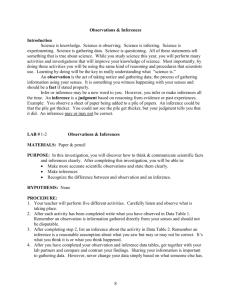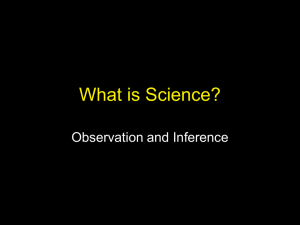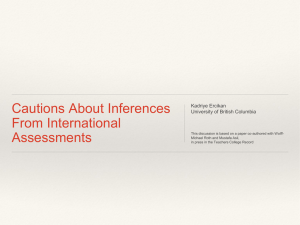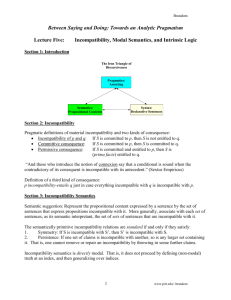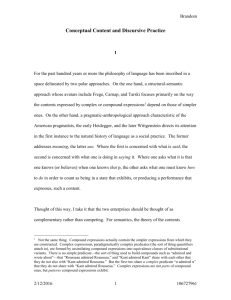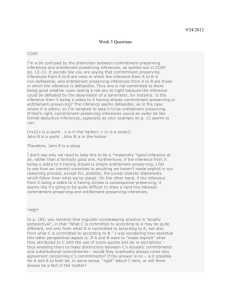Week eight questions
advertisement
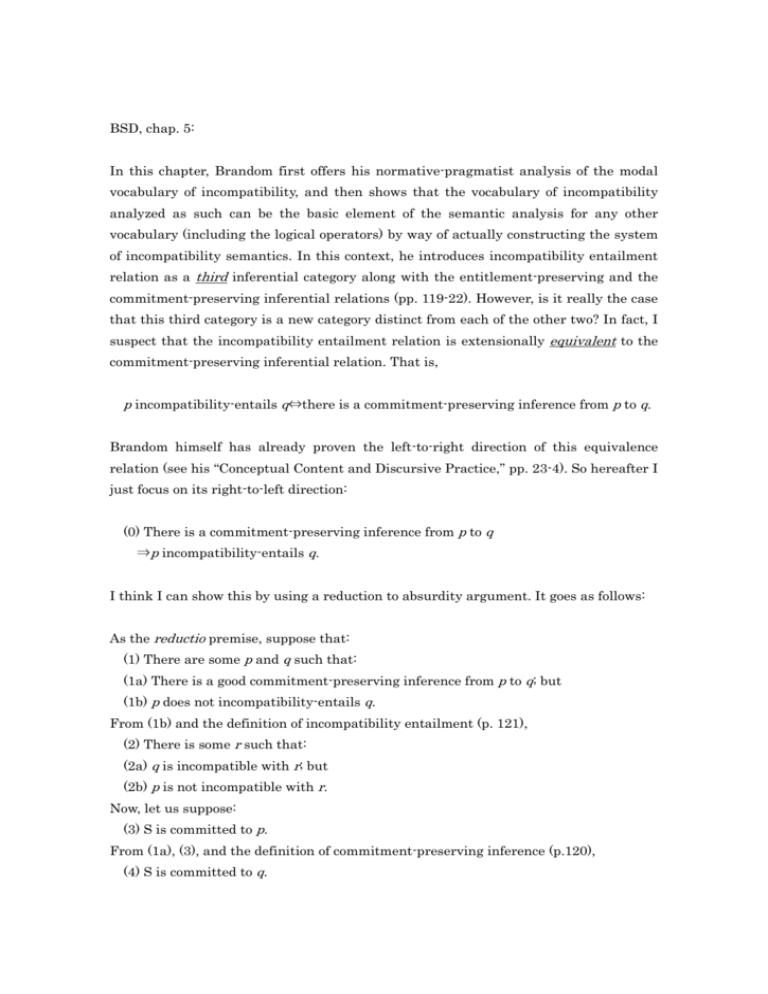
BSD, chap. 5: In this chapter, Brandom first offers his normative-pragmatist analysis of the modal vocabulary of incompatibility, and then shows that the vocabulary of incompatibility analyzed as such can be the basic element of the semantic analysis for any other vocabulary (including the logical operators) by way of actually constructing the system of incompatibility semantics. In this context, he introduces incompatibility entailment relation as a third inferential category along with the entitlement-preserving and the commitment-preserving inferential relations (pp. 119-22). However, is it really the case that this third category is a new category distinct from each of the other two? In fact, I suspect that the incompatibility entailment relation is extensionally equivalent to the commitment-preserving inferential relation. That is, p incompatibility-entails q⇔there is a commitment-preserving inference from p to q. Brandom himself has already proven the left-to-right direction of this equivalence relation (see his “Conceptual Content and Discursive Practice,” pp. 23-4). So hereafter I just focus on its right-to-left direction: (0) There is a commitment-preserving inference from p to q ⇒p incompatibility-entails q. I think I can show this by using a reduction to absurdity argument. It goes as follows: As the reductio premise, suppose that: (1) There are some p and q such that: (1a) There is a good commitment-preserving inference from p to q; but (1b) p does not incompatibility-entails q. From (1b) and the definition of incompatibility entailment (p. 121), (2) There is some r such that: (2a) q is incompatible with r; but (2b) p is not incompatible with r. Now, let us suppose: (3) S is committed to p. From (1a), (3), and the definition of commitment-preserving inference (p.120), (4) S is committed to q. From (4), (2a), and the definition of incompatibility (p. 120), (5) S is not entitled to being committed to r. From (3) and (5), canceling the suppositional context, we get: (6) If S is committed to p, then she is not entitled to being committed to r. From (6) and the definition of incompatibility, (7) p is incompatible with r. However, (7) contradicts with (2) (especially with (2b)). Therefore, the premise (1) is false, which means that there is no counterexample of (0). QED In addition, it seems that we can also use the same basic idea as offered above, mutatis mutandis, to show the equivalency between the generalized incompatibility-entailment and commitment-preserving inferential relations, in which multiple propositions can appear as premise or conclusion. Shuhei Shimamura Ch. 4 I've had a few difficulties understanding how one can be consequentially committed to nonmonotonic inferences that follow from something one says. I worry, that is, about the possibility that one might say something that is true, and thereby commit oneself to something that is false. For instance, if one says, "There is a zebra in the zoo", might commit one to "There is a striped thing in the zoo", which, when it happens that the zoo's zebra is albino, would be something false. My worry is that one seems, in that case, to have erred in the game of giving and asking for reasons without saying anything false. After a bit of thought about this, I eased my worries a bit with the thought that one might be *responsible *for defeating certain inferences that nonmonotonically follow from what one says when they are false. So, in my case, since I know that most people will infer "There is a striped thing in the zoo" from my utterance, I might be obligated to tell them, "But it's not striped", at least in circumstances where it is relevant (i.e. if my friend asked me if there were zebras in the zoo because she'd love to see the stripes.) Is this how you were thinking these cases would work? Ch. 5 It seems like we can get a pretty good analytic-synthetic distinction out of incompatibility entailment, as well as identity of meaning, by way of mutual incompatibility entailments: so, whenever p incompatibility entails q, and q incompatibility entails p, p and q have "the same meaning", and if p incompatibility entails q, then q is an analytic consequence of p. I take it that someone like Quine would be a bit skeptical of the rigid structure that these inferential relations would have to have in order to stand in these sorts of relations. Is it wrong to think that we could get such a distinction out of incompatibility entailment? If not, would it be a problem for the compatibility of the MIE project with BSD if we could get an analytic synthetic distinction out of the BSD materials? -Billy Eck Between Saying and Doing Chapter 4 The non-monotonicity of material inference requires that we determine, for each new commitment, which further commitments would and would not defeat it (with each new belief we associate it with a set of material inferences of which it is a potential defeasor). These associated material inferences determine a range of counterfactual robustness. Since there is an infinite number of claims which are incompatible with any particular claim (given the productivity of language), the ability to practically distinguish relevant from irrelevant commitments is PP-necessary for any ADP(autonomous discursive practice). Does this practical ability also function in determining which inferential commitments are content-conferring and which are not? In Making it Explicit Ch2, Brandom states that “materially good inferences correspond to the conceptual content” (102) and seems to suggest that all inferential relations are part of the conceptual content. However, as was previously discussed in the seminar it seems as though we would want to say that certain inferences are not part of the content of a claim. This was demonstrated in the deviant case where we can make correct inferences from mistaken claims. The deviant case highlighted the necessary distinction between semantic inference (which follows from the descriptive content) and pragmatic inference (which follows only from some specific doing). It seems like this practical ability would be able to make distinctions between the types of inferences and consequently be able to determine which inferences are constitutive of conceptual content. Chapter 5 The persistence of incompatibility appears to be in tension with the non-monotonicity of material inference. Brandom defines the persistence of incompatibility as the claim that “if one set of claims is incompatible with another, so too is any larger set containing it” (123) and the non-monotonicity of material inference as the claim the even though the inference from p to q may be materially good, the inference from p&r to q is not. However, the very examples Brandom uses to demonstrate the non-monotonicity of material inference seem to speak against the persistence of incompatibility. For example, the claim “the match will light when struck” is incompatible with the claim that “the match is inside a strong magnetic field”. However, the claim “the match will light when struck” is NOT incompatible with the set of claims: “the match is inside a strong magnetic field” and “the match is struck inside a faraday cage”. It seems as though Brandom could respond by stating that the two claims “the match will light when struck” and “the match is inside a strong magnetic field” are not really incompatible since the claim “the match will light when struck” has the implicit ceteris paribus premise. If this were the case, then the two claims would in fact not be incompatible. However, it seems that this would lead to the compatibility of “the match will light when struck” (since the inference “if I strike a match, then it will light” is valid) and its negation “the match will not light when struck” (since the inference “if I strike a match, then it will not light” is valid). Laura Davis #1 This question concerns the relata of the VP-suff relation, and so LX diagrams more generally. The Kant-Sellars thesis says that “in *using*ordinary empirical vocabulary, one already knows how to do everything one needs to know how to do in order to introduce and *deploy* modal vocabulary”. This would have the implication, in the reverse direction, that the *usage* of modal vocabulary makes explicit the *usage* of empirical vocabulary. Indeed, modal vocabulary cannot perform any duty without its being (at least) *used* to perform that duty (the same point has been made with much more significance for referring expressions). If that commonplace is accepted, this makes it seem as if the relata flanking the requisite ‘…–suff relation’ are the usage of modal vocabulary and the usage of ordinary empirical vocabulary. Since both relata are practices, the requisite ‘…-suff relation’ is PP-suff, not a VP-suff relation. The same point can be put differently: if the usage of ordinary empirical vocabulary is PP-sufficient for the usage of modal vocabulary, why couldn’t we simply reverse the relation, so as to secure a PP-suff* relation, where * signals explication? More generally, in light of my concern, what is the principled distinction between a vocabulary V and a practice P? unclear whether my concern here is trivial. I am I take it that the motivation for talking in terms of a VP-suff relation, and so culling an explicator V from some P, is to ‘extend the classical project of analysis’. But, in that case you seem to be vacillating between seemingly inconsistent commitments: on the one hand, you cite practices as fundamental to any discursive practice; on the other hand, you betray that affirmation when you move to the project of explication. (This is very similar to the extra question I sent on Oct. 1st). #2 Brandom claims that “one takes or treats *q* as an inferential consequence of *p* in one sense by being disposed to attribute commitment to (what is expressed by) *q* to whomever one credits with commitment to (what is expressed by) *p*”. This suggests, more generally, that for proprieties of inference to be true of a practice is for practitioners within that practice to be disposed to draw inferences according to them. However, simply attributing to an agent *q* along with *p*, or being disposed to do that for all agents, or even agents as such, is something that can be made sense of as a simple *compulsion* on the part of the scorekeeper to attribute *q* along with *p* – she just finds herself with that itch. Though *p *and *q* are individually understood by the scorekeeper and agent, and so cannot be reinterpreted as something other than what it is an understanding of, the link of inferential consequence* *between *p *and *q *has been traded in for a disposition, which *can* be interpreted in an indefinite number of ways. If your response is that the scorekeeper could not so much as understand *p *without viewing it as a inferential consequence of *r*, then it seems that the scorekeeper already understands inferential consequence quite apart from any disposition she may have. Wittgenstein’s point seems, on the face of it, to hold for all dispositional accounts which do not appeal to an understanding of the very thing under question. Shivam Patel




